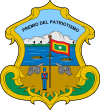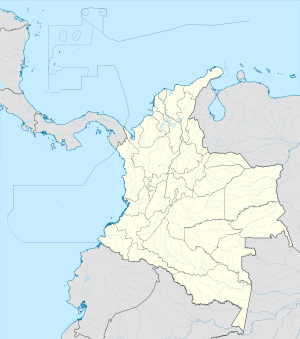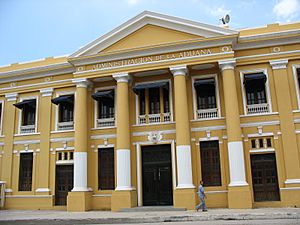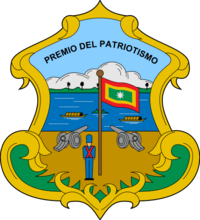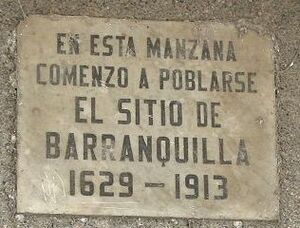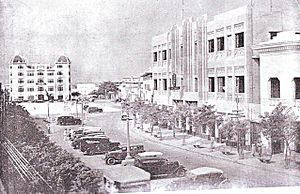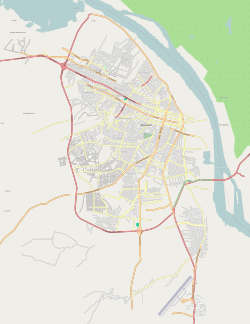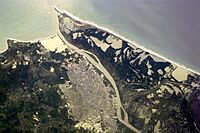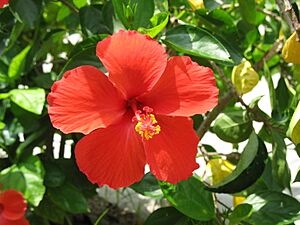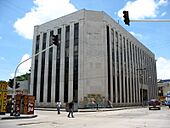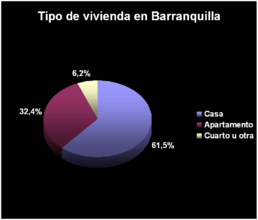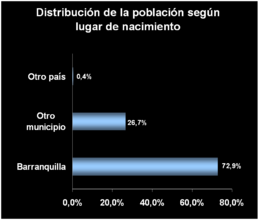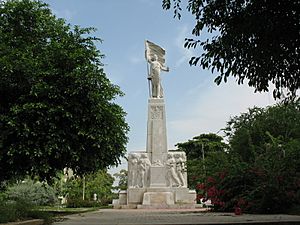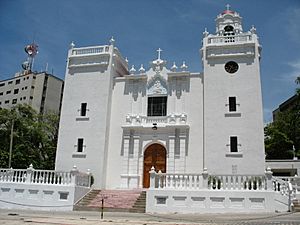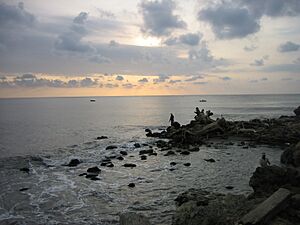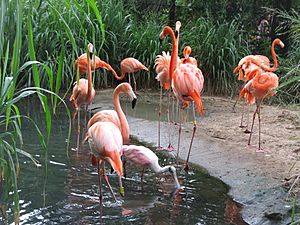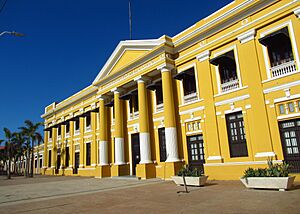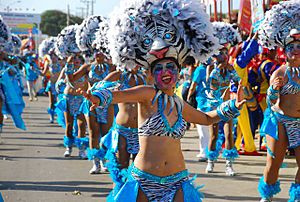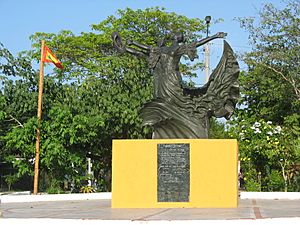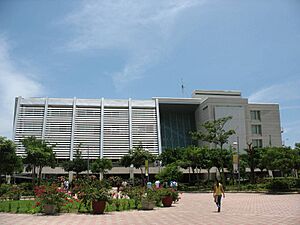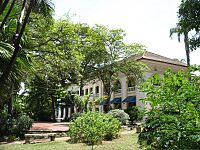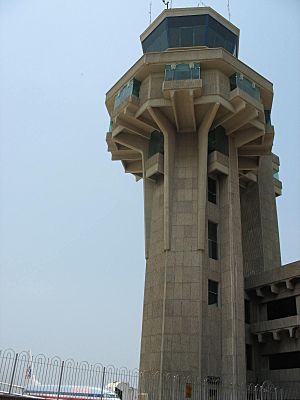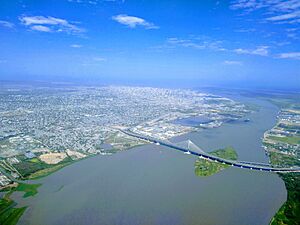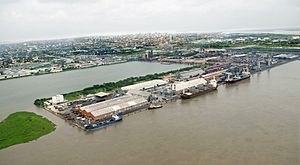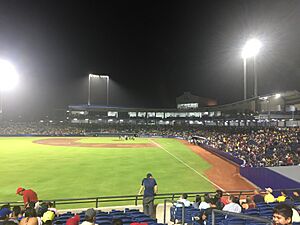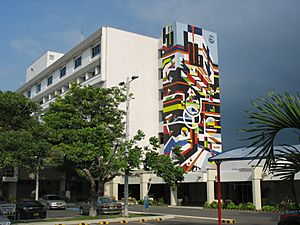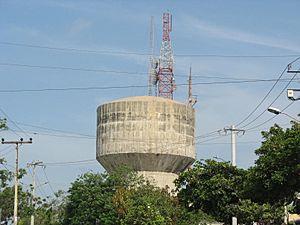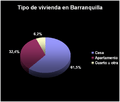Barranquilla facts for kids
Quick facts for kids
Barranquilla
|
|||
|---|---|---|---|
|
District and city
|
|||

From the top: Bolivar walk, Panoramic, Aduana building, Cathedral, Caribbean Cultural Park, Republican mansion.
|
|||
|
|||
| Nickname(s): | |||
| Motto(s):
Ven vive Barranquilla
("Ven vive Barranquilla") |
|||
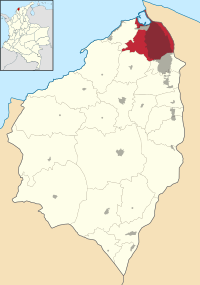
Atlántico Department
|
|||
| Country | |||
| Region | Caribbean | ||
| Department | Atlántico | ||
| Established | April 7, 1813 | ||
| Area | |||
| • District and city | 154 km2 (59.46 sq mi) | ||
| Elevation | 18 m (59 ft) | ||
| Population
(2018)
|
|||
| • District and city | 1,206,319 | ||
| • Estimate
(2023)
|
1,327,209 | ||
| • Rank | ranked 4th | ||
| • Density | 8,618/km2 (22,320/sq mi) | ||
| • Urban | 1,326,588 | ||
| • Metro | 2,370,000 | ||
| Demonym(s) | Barranquillero/a | ||
| GDP (PPP, constant 2015 values) | |||
| • Year | 2023 | ||
| • Total | $29.8 billion | ||
| Time zone | UTC-5 | ||
| Postal code |
080020
|
||
| Area code(s) | 57 + 5 | ||
Barranquilla is a major city in Colombia. It's the capital of the Atlántico department. You can find it close to the Caribbean Sea. It's the biggest city and third-largest port on Colombia's Caribbean coast. In 2018, about 1.2 million people lived there. This makes it Colombia's fourth-largest city, after Bogotá, Medellín, and Cali.
Barranquilla is in a great spot, right next to the Magdalena River. This river flows into the Caribbean Sea. This location makes it a key port for both river and sea travel in Colombia. It's also the main business hub for the Atlántico department. The city is the heart of the Metropolitan Area of Barranquilla, which has over 2 million people. This area includes nearby towns like Soledad, Galapa, Malambo, and Puerto Colombia.
Barranquilla officially became a town on April 7, 1813. But people lived there much earlier, around 1629. It grew into an important port, welcoming immigrants from Europe, the Middle East, and Asia. Because it was so modern and industrialized, it earned the nickname "Colombia's Golden Gate." In the 1940s, Barranquilla was Colombia's second-largest city. It was one of the most modern cities in the Caribbean and South America.
The city hosted the 2018 Central American and Caribbean Games. Barranquilla is also famous for its Carnival of Barranquilla. This festival is a huge cultural event in Colombia. It was named a National Cultural Heritage in 2001 and recognized by UNESCO in 2003.
Ernesto Cortissoz International Airport, built in Barranquilla in 1919, was the first airport in South America. It handles flights within Colombia and to other countries. It was also the first main base for Avianca airlines.
Contents
What's in a Name?
The name "Barranquilla" comes from the word "barranca." This word describes the canyons or ravines that were in the area where the city grew. During the time Spain ruled the Americas, "barranca" was a common name for coastal towns. The area was once known as the Kamash Indian Site. Later, it was called San Nicolás de la Barranquilla, which is where the city's name comes from.
City Nicknames
Barranquilla has several cool nicknames:
- Colombia's Golden Gate: In 1921, President Marco Fidel Suárez gave the city this name. It showed how important Barranquilla was as a port. President Mariano Ospina Pérez repeated this nickname in 1946.
- The Sandy: President Tomás Cipriano de Mosquera called it La Arenosa (The Sandy) in 1849 because of its sandy areas.
- Curramba, the Beautiful: This nickname, Curramba, la Bella, was used by a journalist in the mid-1900s.
- City of the Open Arms: A thinker named Agustín Nieto Caballero used this name, Ciudad de los Brazos Abiertos.
- Beacon of America: Enrique Ancízar called it Faro de América (Beacon/Lighthouse of America).
City Symbols
- Flag
The flag of Barranquilla was first used by patriots in 1811. It has three rectangles: red on the outside, then yellow, and green in the middle.
- Red stands for the blood of patriots.
- Yellow means the sun of freedom and hope.
- Green represents a proud home.
In the center, there's a silver eight-pointed star. This star symbolizes the eight provinces that joined together. Simon Bolívar carried this flag in 1812. In 1910, the city council made it the official flag for Barranquilla.
- Coat of Arms
The city's coat of arms was mentioned in a special order in 1813. This order gave Barranquilla the title of "villa" (town). It was a reward for the brave people who helped defend Cartagena de Indias during the fight for independence.
- Anthem
The song and words for the Barranquilla anthem were chosen in a contest in 1942. The poet Amira de la Rosa wrote the words, and Simón Urbina composed the music.
- Other Symbols
Other symbols of the city include:
- The Hibiscus rosa-sinensis (a type of hibiscus flower).
- The Tabebuia rosea (a pink trumpet tree).
- The Volatinia jacarina (a small bird).
- The iguana (a type of lizard).
City History
Early Days
Unlike many other Colombian cities, Barranquilla wasn't founded by the Spanish. It also didn't start on an old Native American site. The first mention of the area was in 1533. It was a place where Native Americans from Santa Marta would land canoes to trade. The Kamash Indians lived here, and the settlement began around 1629. That's why the city celebrates April 7, 1813, the day it was declared a town, instead of a founding date.
Barranquilla is also known as the birthplace of aviation in South America. The first airline, SCADTA (now Avianca), started here.
A large farm called Hacienda San Nicolás de Tolentino was founded in the 1600s. The owner allowed workers to build homes there. Over time, more people moved in, including Native Americans from nearby towns. By 1681, this farm area was considered a village.
Independence Era (1810–1823)
During Colombia's fight for independence, Barranquilla strongly supported the freedom fighters. On April 7, 1813, the city was given the title of "villa" (town). This was a reward for its bravery in defending Cartagena.
In 1815, Spanish forces attacked Barranquilla, but the people resisted. After several years, the Spanish were finally defeated in 1823. Barranquilla then became part of the Sovereign State of Bolívar. The city also got its first mayor, Agustín Del Valle, that same year.
Modern Times
Barranquilla's importance grew in the mid-1800s. This was thanks to steamships on the Magdalena River. The city became a main port for trading goods, especially coffee. In 1849, the port of Sabanilla was opened for exports, and a customs house was built.
In 1852, Barranquilla became the capital of a new province called Sabanilla. In 1857, it was officially named a "city." The first railway in Colombia, the Bolívar Railway, was built between Barranquilla and Sabanilla in 1871. This helped move goods to and from the port.
The city saw many improvements in the late 1800s:
- A water company was founded in 1877.
- A tram system started in 1884.
- The first telephones in Colombia were installed in 1885.
- The port of Puerto Colombia was built in 1893, becoming the main port for Barranquilla.
1900s
In 1905, Barranquilla became the capital of the new Atlántico department. The Chamber of Commerce was created to support the city's growing economy.
Barranquilla was a pioneer in aviation:
- The first flight in Colombia happened here in 1912.
- In 1919, the second commercial airline in the world, Scadta (now Avianca), started in Barranquilla.
Many immigrants from the Middle East, Europe, and Asia came to Barranquilla. They helped the city's industries grow and made it a modern, multicultural place. This led to Barranquilla being called the "Golden Gate of the Republic."
In the 1960s, the city faced economic challenges. However, in 1993, Barranquilla was named a "Special District, Industrial and Port."
2000s
In the 21st century, Barranquilla is working on new projects to become a key city in Colombia again. It's focusing on improving its infrastructure and urban planning. The city aims to develop further with new projects and increased investment.
City Geography
Barranquilla is in the northeast part of the Atlántico department. It sits on the west bank of the Magdalena River, about 7.5 km (4.7 miles) from where the river meets the Caribbean Sea. The city covers an area of 154 square kilometers (59 square miles).
The city's land is slightly sloped, ranging from 4 meters (13 feet) to 98 meters (321 feet) above sea level. Some areas outside the city can be as high as 120 meters (394 feet).
Barranquilla borders the Magdalena department to the east (across the river). To the north, it meets Puerto Colombia and the Caribbean Sea. To the west, it borders Puerto Colombia, Galapa, and Tubará. To the south, it borders Soledad.
The main river is the Magdalena River. There are also several streams and marshes, like the Mallorquín Swamp.
Climate
Barranquilla has a tropical savanna climate. This means it's hot all year round with high humidity. The average temperature is about 28.4°C (83.1°F). Daytime temperatures are usually around 32°C (90°F). From November to April, trade winds help cool the city a bit.
The rainy seasons are from April to June and from August to November. During these times, some streets can flood, creating "arroyos" (streams). These can be dangerous because some parts of the city don't have good rain drainage.
| Climate data for Barranquilla (Ernesto Cortissoz International Airport), elevation 14 m (46 ft), (1981–2010) | |||||||||||||
|---|---|---|---|---|---|---|---|---|---|---|---|---|---|
| Month | Jan | Feb | Mar | Apr | May | Jun | Jul | Aug | Sep | Oct | Nov | Dec | Year |
| Record high °C (°F) | 38.2 (100.8) |
37.6 (99.7) |
37.8 (100.0) |
39.5 (103.1) |
39.3 (102.7) |
39.8 (103.6) |
39.2 (102.6) |
39.0 (102.2) |
38.4 (101.1) |
38.6 (101.5) |
38.4 (101.1) |
39.5 (103.1) |
39.8 (103.6) |
| Mean daily maximum °C (°F) | 31.4 (88.5) |
31.7 (89.1) |
32.4 (90.3) |
33.1 (91.6) |
33.4 (92.1) |
33.2 (91.8) |
32.9 (91.2) |
33.3 (91.9) |
33.0 (91.4) |
32.5 (90.5) |
32.2 (90.0) |
31.7 (89.1) |
32.6 (90.7) |
| Daily mean °C (°F) | 26.7 (80.1) |
26.8 (80.2) |
27.2 (81.0) |
27.8 (82.0) |
28.2 (82.8) |
28.2 (82.8) |
28.0 (82.4) |
28.1 (82.6) |
27.8 (82.0) |
27.4 (81.3) |
27.5 (81.5) |
27.1 (80.8) |
27.6 (81.7) |
| Mean daily minimum °C (°F) | 23.6 (74.5) |
23.9 (75.0) |
24.2 (75.6) |
24.9 (76.8) |
24.9 (76.8) |
24.8 (76.6) |
24.6 (76.3) |
24.6 (76.3) |
24.1 (75.4) |
23.9 (75.0) |
24.1 (75.4) |
24.0 (75.2) |
24.3 (75.7) |
| Record low °C (°F) | 18.0 (64.4) |
18.0 (64.4) |
18.8 (65.8) |
18.8 (65.8) |
18.0 (64.4) |
20.5 (68.9) |
19.4 (66.9) |
20.9 (69.6) |
20.0 (68.0) |
14.9 (58.8) |
18.5 (65.3) |
19.5 (67.1) |
14.9 (58.8) |
| Average precipitation mm (inches) | 1.2 (0.05) |
0.5 (0.02) |
1.9 (0.07) |
31.8 (1.25) |
118.0 (4.65) |
83.0 (3.27) |
92.1 (3.63) |
112.6 (4.43) |
160.5 (6.32) |
169.6 (6.68) |
95.6 (3.76) |
37.5 (1.48) |
904.2 (35.60) |
| Average precipitation days (≥ 1.0 mm) | 0 | 0 | 1 | 4 | 9 | 10 | 8 | 11 | 14 | 16 | 9 | 3 | 83 |
| Average relative humidity (%) | 79 | 78 | 77 | 79 | 81 | 82 | 81 | 82 | 84 | 86 | 84 | 81 | 81 |
| Mean monthly sunshine hours | 285.2 | 248.4 | 244.9 | 210.0 | 189.1 | 201.0 | 217.0 | 207.7 | 171.0 | 167.4 | 186.0 | 244.9 | 2,572.6 |
| Mean daily sunshine hours | 9.2 | 8.8 | 7.9 | 7.0 | 6.1 | 6.7 | 7.0 | 6.7 | 5.7 | 5.4 | 6.2 | 7.9 | 7.1 |
| Source: Instituto de Hidrologia Meteorologia y Estudios Ambientales | |||||||||||||
| Climate data for Barranquilla (Flores Las), elevation 2 m (6.6 ft), (1981–2010) | |||||||||||||
|---|---|---|---|---|---|---|---|---|---|---|---|---|---|
| Month | Jan | Feb | Mar | Apr | May | Jun | Jul | Aug | Sep | Oct | Nov | Dec | Year |
| Mean daily maximum °C (°F) | 29.1 (84.4) |
28.9 (84.0) |
29.4 (84.9) |
30.1 (86.2) |
31.0 (87.8) |
31.3 (88.3) |
30.9 (87.6) |
31.2 (88.2) |
31.4 (88.5) |
31.0 (87.8) |
30.7 (87.3) |
29.7 (85.5) |
30.4 (86.7) |
| Daily mean °C (°F) | 26.7 (80.1) |
26.6 (79.9) |
26.9 (80.4) |
27.5 (81.5) |
28.2 (82.8) |
28.4 (83.1) |
28.2 (82.8) |
28.3 (82.9) |
28.2 (82.8) |
28.0 (82.4) |
27.9 (82.2) |
27.3 (81.1) |
27.7 (81.9) |
| Mean daily minimum °C (°F) | 25.2 (77.4) |
25.1 (77.2) |
25.4 (77.7) |
25.6 (78.1) |
26.0 (78.8) |
26.2 (79.2) |
26.0 (78.8) |
26.0 (78.8) |
25.7 (78.3) |
25.6 (78.1) |
26.0 (78.8) |
25.7 (78.3) |
25.7 (78.3) |
| Average precipitation mm (inches) | 0.8 (0.03) |
1.3 (0.05) |
1.3 (0.05) |
11.7 (0.46) |
95.6 (3.76) |
72.0 (2.83) |
44.1 (1.74) |
86.9 (3.42) |
135.7 (5.34) |
167.1 (6.58) |
98.6 (3.88) |
35.1 (1.38) |
750.1 (29.53) |
| Average precipitation days (≥ 1.0 mm) | 0 | 0 | 1 | 2 | 7 | 6 | 5 | 7 | 10 | 13 | 7 | 2 | 55 |
| Average relative humidity (%) | 82 | 82 | 82 | 83 | 83 | 83 | 83 | 83 | 83 | 83 | 83 | 82 | 83 |
| Mean monthly sunshine hours | 244.9 | 220.2 | 220.1 | 195.0 | 176.7 | 189.0 | 210.8 | 210.8 | 177.0 | 170.5 | 189.0 | 217.0 | 2,421 |
| Mean daily sunshine hours | 7.9 | 7.8 | 7.1 | 6.5 | 5.7 | 6.3 | 6.8 | 6.8 | 5.9 | 5.5 | 6.3 | 7.0 | 6.6 |
| Source: Instituto de Hidrologia Meteorologia y Estudios Ambientales | |||||||||||||
Plants and Animals


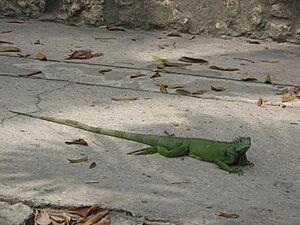
Barranquilla has a dry tropical forest environment. You can find plants like cacti, mangroves, and trees such as divi-divi and flamboyant trees. Along the Magdalena River, there are water plants like Eichhornia azurea and Typha angustifolia.
In the city, common trees include Gliricidia sepium, Cassia nodosa, and various types of Ceiba trees. Fruit trees like mango, sapodilla, and tamarind are also found here.
The city is home to various animals. You can see birds like owls and parrots, fish like mullet in the marshes, and insects like butterflies and mosquitoes. Mammals include rodents and possums. Reptiles like iguanas and snakes also live here. In rural areas, you might find horses, donkeys, cattle, and pigs.
Environment
Barranquilla has important natural areas like the Magdalena River and the Mallorquín Swamp. The city is working on projects to protect these ecosystems. The Barranquilla Botanical Garden is a green space with rare native plants and animals.
Pollution
- Air Quality: The main sources of air pollution are vehicles (34%) and industries (18%). To help, some vehicles are switching to natural gas. Barranquilla is the fourth-biggest industrial air polluter in Colombia.
- Water Pollution: The Magdalena River and Mallorquín Swamp face water pollution from sewage and trash. Efforts are being made to reduce this, like building treatment plants.
- Noise: In the city center, noise from traffic and businesses can be very high. This can be a health risk for people living there.
City Government
Barranquilla is led by a Mayor, who is elected for four years. The current mayor is Jaime Pumarejo Heins, who started his term in 2020. There are also local mayors who help manage different parts of the city.
The governor of Atlántico department, Elsa Noguera, also has offices in Barranquilla. She helps manage important organizations like the Universidad del Atlántico.
City Divisions
| Map of the localities | Urban-rural map |
|---|---|
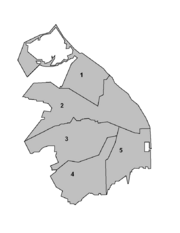 |
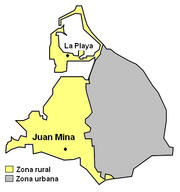 |
| Localities: 1. Riomar 2. Norte-Centro Histórico 3. Sur Occidente 4. Sur Oriente. |
Corregimientos: 1. La Playa (Eduardo Santos) 2. Juan Mina. |
Barranquilla is divided into five main areas called localities: Riomar, Norte-Centro Histórico, Sur Occidente, Sur Oriente, and Metropolitana. Each locality has its own local mayor. These localities are further divided into 188 neighborhoods, or barrios.
The city also includes the neighborhood of Las Flores, the village of La Playa, and the western breakwater of Bocas de Ceniza. The village of Juan Mina is also part of the city's authority.
Metropolitan Area
The Barranquilla Metropolitan Area includes Barranquilla and nearby towns like Soledad, Galapa, Puerto Colombia, and Malambo. This larger area was created in 1979 to help with planning and development. It's managed by a Metropolitan Board, led by Barranquilla's mayor.
| Municipality | Area km2 |
Population
(Census 2018) |
Population
(Estimate 2023) |
Population
density 2023 (pop/km2) |
Altitude m |
Distance from Barranquilla (km) |
Metropolitan map |
|---|---|---|---|---|---|---|---|
| Barranquilla | 154 | 1.206.319 | 1.327.209 | 8.618 | 18 | 0 | |
| Soledad | 67 | 603.999 | 692.799 | 10.340 | 5 | 3 | |
| Malambo | 108 | 128.203 | 145.396 | 1.346 | 10 | 12 | |
| Puerto Colombia | 93 | 49.264 | 55.890 | 601 | 5 | 13 | |
| Galapa | 98 | 60.708 | 69.820 | 712 | 83 | 8 | |
| Total | 520 | 2.048.493 | 2.291.114 | 4.406 | — | — | |
| Census 2005, 2014 estimates by DANE – Official municipal websites | |||||||
Defense
Barranquilla is home to the First Division of the National Army of Colombia. The Colombian Air Force also has a base nearby in Malambo. These forces help keep the country safe and protect its borders.
State Institutions
Many important government offices for the region are in Barranquilla. These include the Attorney General's Office, the National Police, and various social services.
City Economy
| Economic indicators | |
|---|---|
| GDP: (2006) |
US $4,605 million COP $10,858,185 million |
| GDP per capita: (2006) |
US $2,209 COP $4,945,029 |
| Unemployment rate: (2010) |
9.2% |
| Annual inflation: (2010) |
3.38% |
| Monthly inflation: (2010) |
0.28% |
| Country risk: (2009) |
38.85 points |
| Data retrieved from the Barranquilla Chamber of Commerce – Source: DANE. | |
Barranquilla is a major industrial city. Its economy is very active, focusing on industry, trade, finance, services, and fishing. Some of the products made here include:
- Vegetable fats and oils
- Medicines and chemicals
- Shoes and dairy products
- Drinks, soaps, and building materials
- Furniture, plastics, and cement
- Metal parts, clothes, buses, and boats
- Petroleum products
The city's port is very important. It handles cotton, coffee, and oil, along with many other industrial products. The port connects to the Magdalena River, which goes inland, and to the Caribbean Sea for international trade. Barranquilla's airport is one of only two in Colombia allowed for international cargo.
Immigrants from the Middle East and other countries helped boost Barranquilla's economy. They started many businesses and contributed to the city's growth.
Economic Zones
Barranquilla has several industrial parks and free trade zones. The Zona Franca de Barranquilla is the oldest and largest free trade zone in Colombia. It has about 90 companies operating there. New zones are also being built to support more businesses.
The city's sea and river ports are key to its economic growth. They allow millions of tons of goods to be traded with the United States, Europe, and Asia. There are also plans for a "Superpuerto" (Deep Water Port) to handle even more cargo, especially coal.
City Population
In 2005, Barranquilla had a population of about 1.15 million people. Its metropolitan area had over 1.8 million. This makes it the most populated city on the Colombian Caribbean Coast and the fourth largest in the country.
Most people (about 1.14 million) live in urban areas. The population density is about 6,918 people per square kilometer. Slightly more than half of the population (52.5%) are female.
In 2005, most people (61.5%) lived in houses, and 32.4% lived in apartments. Many people who moved to Barranquilla did so for family reasons (63.3%).
City Layout
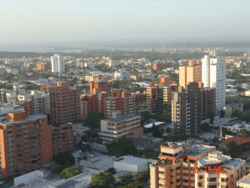
Historic Center
The Centro histórico (Historic Center) is a very old and important part of Barranquilla. It holds many government offices. This area was once the most important for business until the 1980s. Even though some businesses moved north, the center is still very active with markets and historical buildings. It's a protected site because of its history and architecture. Efforts are being made to restore and improve this area.
- El Paseo de Bolívar
The Paseo de Bolívar is the main avenue in the heart of Barranquilla. It's where the city first started to grow. It used to be called Calle Ancha (Broad Street). In 1937, a statue of Simon Bolívar was placed there, and it was renamed Paseo de Bolívar. This area has many old buildings that are being restored.
Public Spaces
Barranquilla has many public spaces like plazas and parks. These areas are important for community life and recreation.
- Plazas
- Plaza de Bolívar: This plaza is in the city center and is being restored.
- Plaza de San Nicolás: Located in front of the San Nicolás church, it was once a busy cultural and commercial hub.
- Plaza de la Paz: Built in 1986 for Pope John Paul II's visit, it's a major spot for public gatherings.
- Plazuela Esthercita Forero: Built in 2003, it honors the composer Esthercita Forero.
- Plaza Mario Santo Domingo: Part of the Caribbean Cultural Park.
- Plaza de la Locomotora: Built in 2002, it displays an old locomotive.
- Parks
- Parque Tomás Surí Salcedo: Built in 1921, it has rides and a basketball arena.
- Parque Metropolitano: Located near the Roberto Melendez stadium, it has a sculpture of Shakira.
- Parque Santander: In the traditional El Prado neighborhood.
- Parque de Los Fundadores: In El Prado, it has monuments to aviation pioneers.
- Monuments
Barranquilla has many monuments that honor heroes, important people, and historical events. Some key ones are:
- The statue of Simón Bolívar (1919).
- The statue of Christopher Columbus (1892).
- The Statue of Liberty (1910).
- The statue of General Francisco de Paula Santander (1922).
- The Monumento a la Bandera (Monument to the Flag) (1932).
Three historic cannons used in the independence fight were restored in 2007.
Architecture
Most of Barranquilla's buildings were built in the 20th century. The city has a mix of styles, showing the influence of immigrants from around the world. You can see neoclassical, art deco, and modern styles.
- Republican Architecture
This style refers to buildings from after Colombia's independence (1819) until about 1930. Examples include Instituto La Salle and the Hotel El Prado.
- Art Deco (1930–1945)
This style is known for its geometric shapes and decorative elements. Many buildings from the 1930s in Barranquilla have this style, like the Estadio Romelio Martínez (1935) and the Rex Theatre (1935).
- Modern Movement (1945–1970)
Modern architecture is simpler, without much decoration. Important examples include the National Building (1945) and Queen Mary's Cathedral (started in 1955).
- Contemporary Architecture
Newer buildings include the World Trade Center of Barranquilla and many apartment towers in the north of the city.
- Religious Buildings
Barranquilla has many churches and other places of worship. They show a variety of architectural styles, from Gothic to Baroque. Some famous ones include:
- María Reina Metropolitan Cathedral, known for its beautiful stained glass.
- San Nicolás de Tolentino Church, with strong neo-Gothic style.
- San Roque Church, known for its tall clock towers.
- Inmaculada Concepción Church, a symbol of Republican architecture.
- Shaare Sedek Synagogue.
- Othman Ben Affan Mosque.
Tourist Spots
Barranquilla is a lively city for tourists, especially during Carnival. The northern part of the city is the most modern, with good hotels and shopping centers.
The city has many hotels, from small inns to 5-star international chains. The best hotels are in the north, close to business and shopping areas.
Barranquilla offers many places to shop. The main shopping areas are in the city center and the north. Calle 98 in the north is an exclusive area with new shopping centers.
Here are some main tourist sites:
- Bocas de Ceniza and the Magdalena River
Bocas de Ceniza is where the Magdalena River meets the Caribbean Sea. It's important for accessing Barranquilla's port. You can take boat trips along the river to see the area.
- The Port of Puerto Colombia
This pier was built in 1893 and was once one of the longest in the world. Thousands of immigrants arrived in Colombia through this port. Sadly, it has been damaged and is mostly closed now, but there are plans to rebuild it.
- Barranquilla Zoo
The Barranquilla Zoo is a home for many native and foreign animals. It focuses on Colombian animals and protecting endangered species. It has over 500 animals from 140 different species.
Around Barranquilla
Within an hour's drive, you can find several tourist spots:
- Beaches like Pradomar, Salgar, and Puerto Colombia.
- Lakes like Cisne Lake, where you can do water sports.
- Paragliding at Cupino hill in Puerto Colombia.
- In Usiacurí, you can visit the house of poet Julio Flórez and buy handicrafts.
Cultural Places
Amira de la Rosa Theater
This theater is a key cultural spot in Barranquilla. It opened in 1976 and hosts concerts, meetings, and exhibitions. It's named after the famous playwright and poet Amira de la Rosa.
Museums
- Museo Romántico (Romantic Museum): Shows objects from the city's history, including Carnival costumes and a typewriter used by Gabriel García Márquez.
- Museo del Caribe (Museum of the Caribbean): Located in the Caribbean Cultural Park, it explores the natural, cultural, and historical aspects of the Colombian Caribbean.
- Museo Antropológico y Etnológico (Anthropological and Ethnological Museum): Has a collection of items from indigenous cultures of the region.
- Museo de Arte Moderno (Museum of Modern Art): Features works by important artists like Fernando Botero and Alejandro Obregón.
- Museo Aeronáutico (Aeronautical Museum): Honors Barranquilla's role in early commercial aviation.
- Museo del Atlántico (Museum of the Atlantic): A new regional museum covering over 4,000 square meters.
- Museo del Carnaval (Carnival Museum): Opened in 2011, it celebrates the famous Carnival of Barranquilla.
Cultural Sites and Organizations
- Parque Cultural del Caribe
This is a large cultural complex that promotes the natural, cultural, and historical aspects of the Colombian Caribbean. It includes the Museum of the Caribbean, a children's library, and a library focused on Gabriel García Márquez.
- Centro Cultural Colombo Americano
This center promotes American culture and the English language in Barranquilla. It offers English classes, educational advice, and a bilingual library. It also hosts many free cultural events.
- Former Customs Building
The old customs buildings have been restored and are now a cultural complex. They house libraries, a historical archive, and a musical documentation center.
City Culture
Barranquilla is known for its vibrant culture. The most famous event is the Carnival of Barranquilla. It's a huge multicultural festival held every year in February or early March. It features four days of celebrations, costumes, and parades. In 2003, UNESCO recognized it as a "Masterpiece of Oral and Intangible Heritage of Humanity."
The city has many folk dances, songs, games, and stories. Many of these traditions are highlighted during the Carnival. Barranquilla also hosts other cultural events like art shows, literary workshops, concerts, and festivals like Barranquijazz.
Music
Cumbia is the most important traditional music and dance in Barranquilla and the Caribbean region. Other popular rhythms include jalao, puya, and vallenato. Traditional dances include Congo, Mapalé, and Son de Negro.
Famous salsa singer Joe Arroyo loved Barranquilla and its Carnival. He lived and was buried in the city. A statue in his honor was built in 2011. Shakira, who was born in Barranquilla, has also paid tribute to Joe Arroyo's music.
Events
Besides the Carnival, other important cultural events in Barranquilla include:
- Barranquijazz: A jazz festival with international artists.
- Carnaval de las Artes: A cultural event bringing together writers, filmmakers, musicians, and artists.
- Feria Artesanal y Folclórica: A craft and folk fair.
- Festival Internacional de Cuenteros: A storytelling festival.
- Plataforma K: An annual fashion event.
Food
Barranquilla offers a wide variety of food, from local dishes to international cuisines. Because of the many immigrants, you can find Syrian-Lebanese, Chinese, Japanese, and Italian food.
Typical local dishes include:
- Plain rice with cassava buns.
- Sancocho de guandú (pigeon pea stew with salted meat).
- Butifarras soledeñas (sausages).
- Fried arepas, carimañolas, and empanadas.
- Seafood stew (Cazuela de mariscos).
- Fast food like Chuzo desgranado.
For drinks, you can try raspao (shaved ice), boli (ice pop), and fruit juices like tamarindo.
Education
Barranquilla has a strong education system, from primary school to university. Many students from other regions come here for higher education.
In 2005, most children aged 3-17 attended school. About 12.8% of the population had a professional degree. Most people (94.1%) aged 5 and over can read and write.
Universities
Barranquilla is home to several universities known for their high academic standards:
- Universidad del Norte
- Universidad del Atlántico
- Universidad Autónoma del Caribe
- Universidad Libre Seccional Barranquilla
- Universidad Simón Bolívar
- Universidad Metropolitana
These universities offer many programs, including engineering, health sciences, business, basic sciences, education, social sciences, and fine arts. They also offer master's and doctoral degrees.
Schools and Technical Training
The city has many public and private high schools. The National Training Service (SENA) provides important technical and technological training. There are four SENA centers in Barranquilla. The Instituto Tecnológico de Soledad Atlántico (ITSA) also offers technical courses to many students.
Educational Growth
Since 2008, Barranquilla has been building new educational parks and modern colleges. These new facilities include libraries, auditoriums, computer rooms, and sports areas. In 2009, a school built by Shakira was opened in La Playa.
Science and Research
Universities in Barranquilla are active in scientific research. They study fields like medicine, chemistry, biology, law, history, and engineering. The city has several public libraries, including the Barranquilla Departmental Library.
City Transportation
Ernesto Cortissoz International Airport was built in Barranquilla in 1919. It was the first airport in South America. It serves both domestic and international flights.
The Pumarejo Bridge over the Magdalena River is one of the longest bridges in Colombia, at over 1.5 km (0.9 miles).
Barranquilla has a public transport system called TransMetro. It uses special buses that travel on dedicated lanes. About 110,000 people use it daily. A light rail line is also being planned.
Taxis are available, with fares depending on the distance. Buses and minibuses are also common, with fares varying by vehicle type. The Metropolitan Transportation Terminal in Soledad allows travel by land to other parts of Colombia and Venezuela.
Barranquilla has a major sea and river port, which is the third largest in Colombia by cargo volume. It's managed by a private company and handles trade with many countries.
Public Transportation Facts
On average, people in Barranquilla spend about 77 minutes commuting on public transit each weekday. About 17% of riders travel for more than 2 hours daily. The average wait time at a stop is 15 minutes. The average distance for a single trip is 5.9 km (3.7 miles).
City Sports
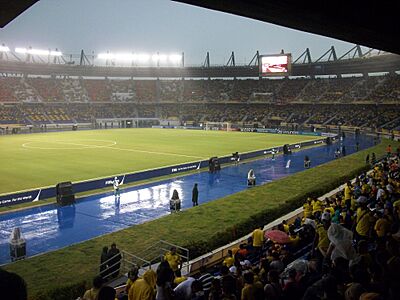
Sports are very popular in Barranquilla, especially football, baseball, and boxing. Other sports include basketball, athletics, swimming, and cycling.
Barranquilla has hosted the Colombia national football team for World Cup qualifiers many times. It has also hosted major international events like the Central American and Caribbean Games in 1946, 2006, and 2018.
Stadiums and Venues
The city has good sports facilities:
- Estadio Metropolitano Roberto Meléndez: Opened in 1986, it can hold almost 50,000 spectators. It has a football field and a running track.
- Estadio Romelio Martínez: Built in 1935, it can hold 20,000 people. It was renovated in 2018.
- Estadio Édgar Rentería: This baseball stadium was rebuilt in 2018 and can hold 12,000 fans. It honors baseball player Édgar Rentería.
- Estadio de Baloncesto Elías Chegwin: Opened in 1992 and renovated in 2018, it's the only air-conditioned sports arena in Colombia.
The city also has a shooting range, a skating rink, tennis courts, and a BMX track.
Sports Teams
Barranquilla has several professional sports teams:
- Club Deportivo Popular Junior F.C. (football): Plays in the first division.
- Barranquilla F.C. (football): Plays in the second division.
- Caimanes de Barranquilla (baseball): The city's team in the Colombian Professional Baseball League.
- Titanes de Barranquilla (basketball): Has won the Colombian professional tournament multiple times.
| Team | League | Sport | Stadium | Founded | Champions |
|---|---|---|---|---|---|
| Club Deportivo Popular Junior F.C. | Primera A | Football | Estadio Metropolitano Roberto Meléndez | 1924 | 13 |
| Caimanes BBC | LCBP | Baseball | Estadio Tomás Arrieta | 1984 | 10 |
| Barranquilla F.C. | Primera B | Football | Estadio Romelio Martínez | 2005 | 0 |
| Titanes de Barranquilla | Baloncesto Profesional Colombiano, Basketball Champions League | Basketball | Arena Deportiva Elías Chegwin | 2018 | 4 |
Formula One
In 2022, Barranquilla's mayor discussed the possibility of hosting a Formula One race in the city. This race would be called the Caribbean Grand Prix. If it happens, it could bring many benefits to the city and country.
City Healthcare
Healthcare in Barranquilla is managed by the Ministry of Health and other state organizations. The city has public hospitals and health centers that provide medical services. There are also many private clinics that offer specialized medical care.
City Media
Television
Barranquilla is home to Telecaribe, a regional television channel for the Colombian Caribbean Coast. There are also local channels and the main national television channels available.
Radio
The city has many AM and FM radio stations. They provide news and a variety of music programs.
Press
The two main newspapers in Barranquilla are El Heraldo and La Libertad. National newspapers like El Tiempo are also available.
Music References
Barranquilla is mentioned in the song "I've been Everywhere" by Hank Snow. Shakira, who is from Barranquilla, also mentions the city in her songs "Hips Don't Lie" and "La Bicicleta".
Famous People from Barranquilla
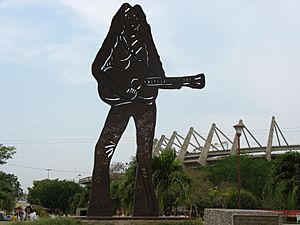
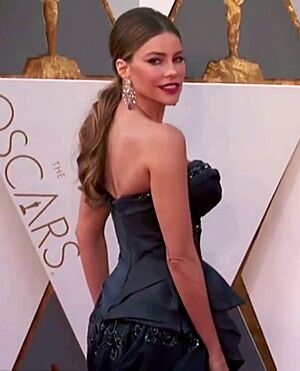
- Shakira (singer)
- Sofía Vergara (actress)
- Esther Forero (composer)
- Carmen Villalobos (actress)
- Andrés Cabas (singer)
- Alvaro Cepeda Samudio (writer)
- Salomón Hakim (scientist)
- Julio Mario Santo Domingo (businessman)
- Nina García (fashion editor)
- Teófilo Gutiérrez (footballer)
- Maía (singer)
- Edgar Perea (sports announcer)
- Édgar Rentería (baseball player)
- Maritza Rodríguez (actress)
- Amira de la Rosa (poet)
- Valerie Domínguez (model, actress)
- Isabella Santo Domingo (actress, writer)
- Donovan Solano (baseball player)
- Jhonatan Solano (baseball player)
- Silvia Tcherassi (fashion designer)
- Daniella Álvarez (model)
- Paulina Vega Dieppa (Miss Universe 2014)
- Ariadna Gutiérrez (Miss Colombia 2014)
- Aníbal Velásquez (musician)
- Roberto McCausland Dieppa (composer)
- Natasha Klauss (actress)
Sister Cities
Barranquilla has sister city relationships with several cities around the world:
 Tula, Russia
Tula, Russia Buenos Aires, Argentina
Buenos Aires, Argentina Kaohsiung, Taiwan
Kaohsiung, Taiwan Nanjing, People's Republic of China
Nanjing, People's Republic of China Brownsville, Texas, United States
Brownsville, Texas, United States Tampa, Florida, United States
Tampa, Florida, United States Miami, Florida, United States
Miami, Florida, United States Aberdeen, Scotland
Aberdeen, Scotland
Images for kids
-
Edificio García (1938), Art déco.
See Also
 In Spanish: Barranquilla para niños
In Spanish: Barranquilla para niños



